Seat Leon 5D 2011 Owner's manual
Manufacturer: SEAT, Model Year: 2011, Model line: Leon 5D, Model: Seat Leon 5D 2011Pages: 302, PDF Size: 4.17 MB
Page 141 of 302
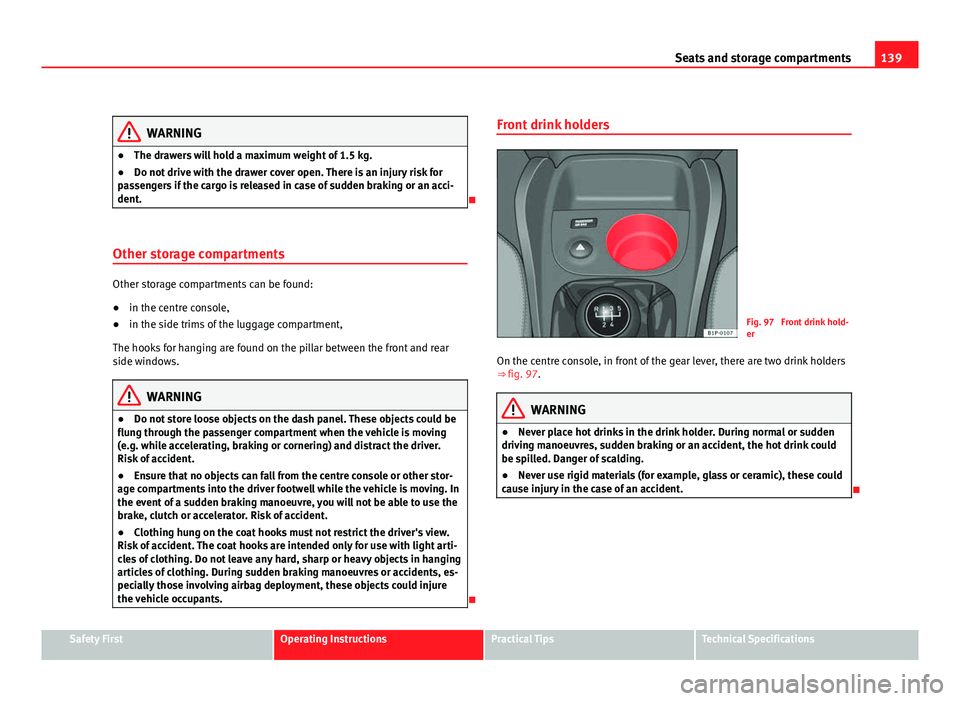
139
Seats and storage compartments
WARNING
● The drawers will hold a maximum weight of 1.5 kg.
● Do not drive with the drawer cover open. There is an injury risk for
passengers if the cargo is released in case of sudden braking or an acci-
dent.
Other storage compartments
Other storage compartments can be found:
● in the centre console,
● in the side trims of the luggage compartment,
The hooks for hanging are found on the pillar between the front and rear
side windows.
WARNING
● Do not store loose objects on the dash panel. These objects could be
flung through the passenger compartment when the vehicle is moving
(e.g. while accelerating, braking or cornering) and distract the driver.
Risk of accident.
● Ensure that no objects can fall from the centre console or other stor-
age compartments into the driver footwell while the vehicle is moving. In
the event of a sudden braking manoeuvre, you will not be able to use the
brake, clutch or accelerator. Risk of accident.
● Clothing hung on the coat hooks must not restrict the driver's view.
Risk of accident. The coat hooks are intended only for use with light arti-
cles of clothing. Do not leave any hard, sharp or heavy objects in hanging
articles of clothing. During sudden braking manoeuvres or accidents, es-
pecially those involving airbag deployment, these objects could injure
the vehicle occupants.
Front drink holders
Fig. 97 Front drink hold-
er
On the centre console, in front of the gear lever, there are two drink holders
⇒ fig. 97.
WARNING
● Never place hot drinks in the drink holder. During normal or sudden
driving manoeuvres, sudden braking or an accident, the hot drink could
be spilled. Danger of scalding.
● Never use rigid materials (for example, glass or ceramic), these could
cause injury in the case of an accident.
Safety FirstOperating InstructionsPractical TipsTechnical Specifications
Page 142 of 302
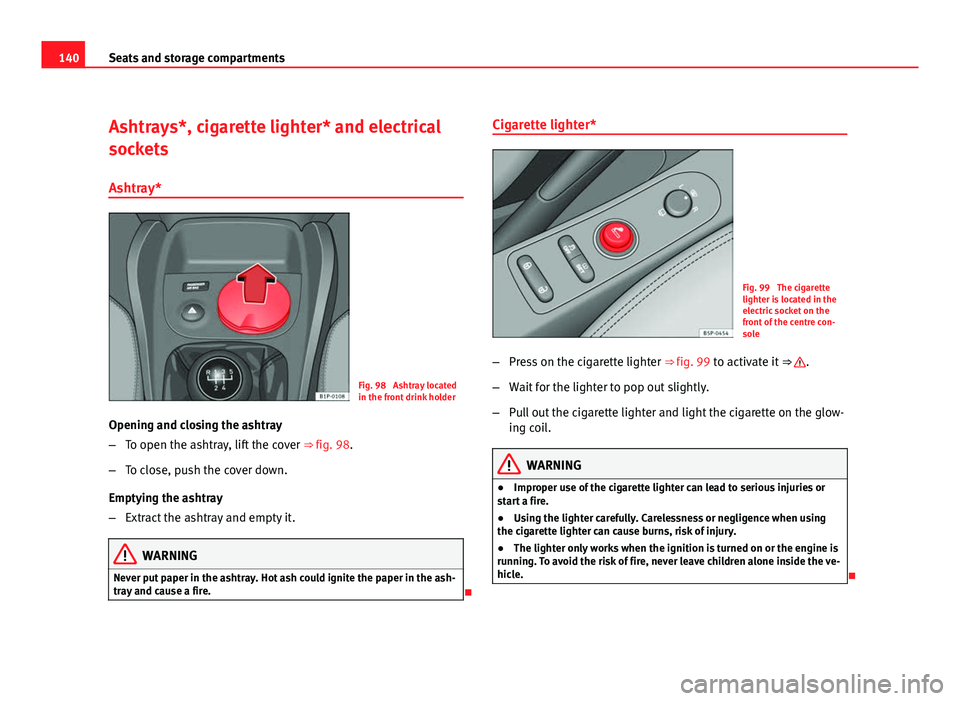
140Seats and storage compartments
Ashtrays*, cigarette lighter* and electrical
sockets
Ashtray*
Fig. 98 Ashtray located
in the front drink holder
Opening and closing the ashtray
– To open the ashtray, lift the cover ⇒ fig. 98.
– To close, push the cover down.
Emptying the ashtray
– Extract the ashtray and empty it.
WARNING
Never put paper in the ashtray. Hot ash could ignite the paper in the ash-
tray and cause a fire.
Cigarette lighter*
Fig. 99 The cigarette
lighter is located in the
electric socket on the
front of the centre con-
sole
– Press on the cigarette lighter ⇒ fig. 99 to activate it ⇒
.
– Wait for the lighter to pop out slightly.
– Pull out the cigarette lighter and light the cigarette on the glow-
ing coil.
WARNING
● Improper use of the cigarette lighter can lead to serious injuries or
start a fire.
● Using the lighter carefully. Carelessness or negligence when using
the cigarette lighter can cause burns, risk of injury.
● The lighter only works when the ignition is turned on or the engine is
running. To avoid the risk of fire, never leave children alone inside the ve-
hicle.
Page 143 of 302
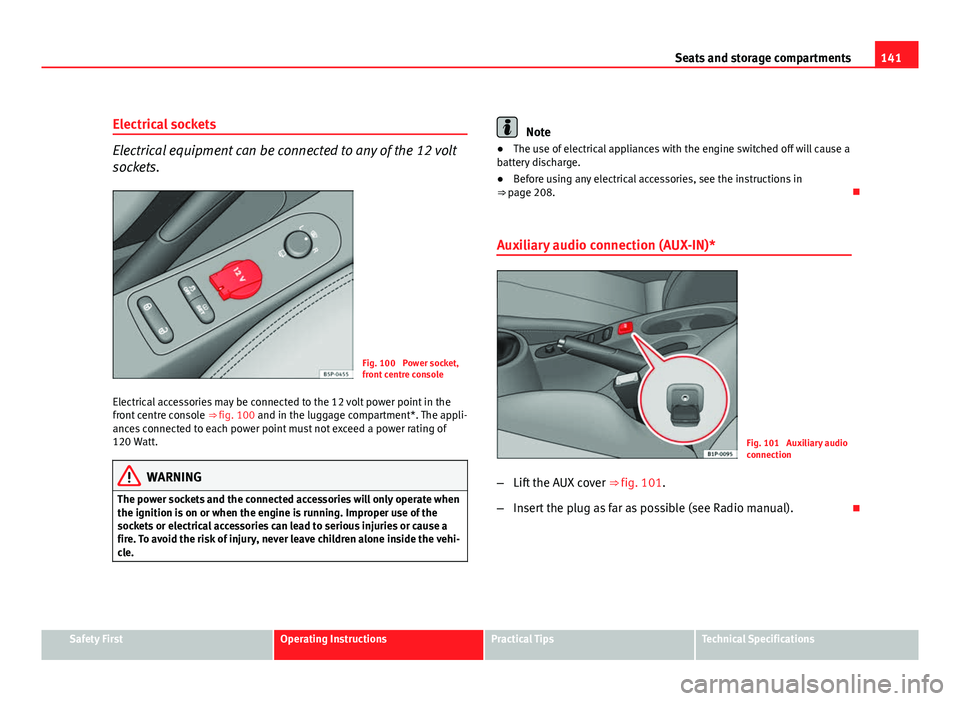
141
Seats and storage compartments
Electrical sockets
Electrical equipment can be connected to any of the 12 volt
sockets.
Fig. 100 Power socket,
front centre console
Electrical accessories may be connected to the 12 volt power point in the
front centre console ⇒ fig. 100 and in the luggage compartment*. The appli-
ances connected to each power point must not exceed a power rating of
120 Watt.
WARNING
The power sockets and the connected accessories will only operate when
the ignition is on or when the engine is running. Improper use of the
sockets or electrical accessories can lead to serious injuries or cause a
fire. To avoid the risk of injury, never leave children alone inside the vehi-
cle.
Note
● The use of electrical appliances with the engine switched off will cause a
battery discharge.
● Before using any electrical accessories, see the instructions in
⇒ page 208.
Auxiliary audio connection (AUX-IN)*
Fig. 101 Auxiliary audio
connection
– Lift the AUX cover ⇒ fig. 101.
– Insert the plug as far as possible (see Radio manual).
Safety FirstOperating InstructionsPractical TipsTechnical Specifications
Page 144 of 302

142Seats and storage compartments
MEDIA-IN* connector
Fig. 102 Opening con-
nector on centre console
Fig. 103 Connector on
the centre console
For information concerning the use of this equipment, please see the Radio
handbook. First-aid kit, warning triangle, fire
extinguisher
Warning triangle
Fig. 104 Housing for the
emergency warning trian-
gle in the boot
The emergency warning triangle can be fitted in the side lining of the lug-
gage compartment.
Note
● The warning triangle is not part of the vehicle's standard equipment.
First-aid kit and fire extinguisher
The first aid kit* can be housed in a storage box in the left side lining of the
luggage compartment.
Page 145 of 302

143
Seats and storage compartments
The fire extinguisher* is attached to the luggage compartment carpet with
Velcro.
Note
● The first-aid kit and the fire extinguisher are not part of the vehicle's
standard equipment.
● The first aid kit must comply with legal requirements.
● Observe the expiry date of the contents of the first aid kit. After it has
expired you should purchase a new one.
● The fire extinguisher must comply with legal requirements.
● Ensure that the fire extinguisher is fully functional. The fire extinguisher
should, therefore, be checked regularly. The sticker on the fire extinguisher
will inform you of the next date for checking.
● Before acquiring accessories and emergency equipment see the instruc-
tions in ⇒ page 208.
Luggage compartment
Storing objects
All luggage must be securely stowed. Please observe the following points to ensure the vehicle handles
well at all times:
– Distribute the load as evenly as possible.
– Place heavy objects as far forward in the luggage compartment
as possible. –
Secure luggage in the luggage compartment with suitable
straps on the fastening rings.
WARNING
● Loose luggage and other loose items in the vehicle can cause serious
injuries.
● Loose objects in the luggage compartment can suddenly move and
change the way the vehicle handles.
● During sudden manoeuvres or accidents, loose objects in the passen-
ger compartment can be flung forward, injuring vehicle occupants.
● Always store objects in the luggage compartment and secure with
suitable straps. This is especially important for heavy objects.
● When you transport heavy objects, always take in account that a
change in the centre of gravity can also cause changes in vehicle han-
dling.
● Please observe information on safe driving ⇒ page 7, Safe driving.
CAUTION
Hard objects on the shelf could chafe against the wires of the heating ele-
ment in the rear window and cause damage.
Note
The ventilation slots in front of the rear side windows must not be covered
as this would prevent stale air being extracted from the vehicle.
Safety FirstOperating InstructionsPractical TipsTechnical Specifications
Page 146 of 302
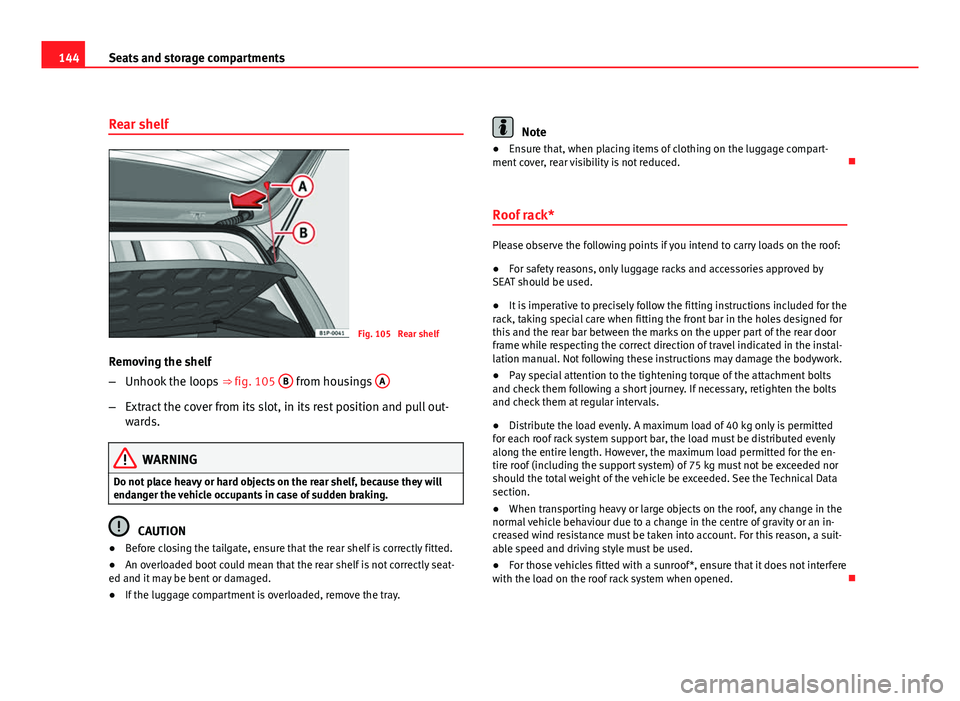
144Seats and storage compartments
Rear shelf
Fig. 105 Rear shelf
Removing the shelf
– Unhook the loops ⇒ fig. 105 B
from housings A
–
Extract the cover from its slot, in its rest position and pull out-
wards.
WARNING
Do not place heavy or hard objects on the rear shelf, because they will
endanger the vehicle occupants in case of sudden braking.
CAUTION
● Before closing the tailgate, ensure that the rear shelf is correctly fitted.
● An overloaded boot could mean that the rear shelf is not correctly seat-
ed and it may be bent or damaged.
● If the luggage compartment is overloaded, remove the tray.
Note
● Ensure that, when placing items of clothing on the luggage compart-
ment cover, rear visibility is not reduced.
Roof rack*
Please observe the following points if you intend to carry loads on the roof:
● For safety reasons, only luggage racks and accessories approved by
SEAT should be used.
● It is imperative to precisely follow the fitting instructions included for the
rack, taking special care when fitting the front bar in the holes designed for
this and the rear bar between the marks on the upper part of the rear door
frame while respecting the correct direction of travel indicated in the instal-
lation manual. Not following these instructions may damage the bodywork.
● Pay special attention to the tightening torque of the attachment bolts
and check them following a short journey. If necessary, retighten the bolts
and check them at regular intervals.
● Distribute the load evenly. A maximum load of 40 kg only is permitted
for each roof rack system support bar, the load must be distributed evenly
along the entire length. However, the maximum load permitted for the en-
tire roof (including the support system) of 75 kg must not be exceeded nor
should the total weight of the vehicle be exceeded. See the Technical Data
section.
● When transporting heavy or large objects on the roof, any change in the
normal vehicle behaviour due to a change in the centre of gravity or an in-
creased wind resistance must be taken into account. For this reason, a suit-
able speed and driving style must be used.
● For those vehicles fitted with a sunroof*, ensure that it does not interfere
with the load on the roof rack system when opened.
Page 147 of 302
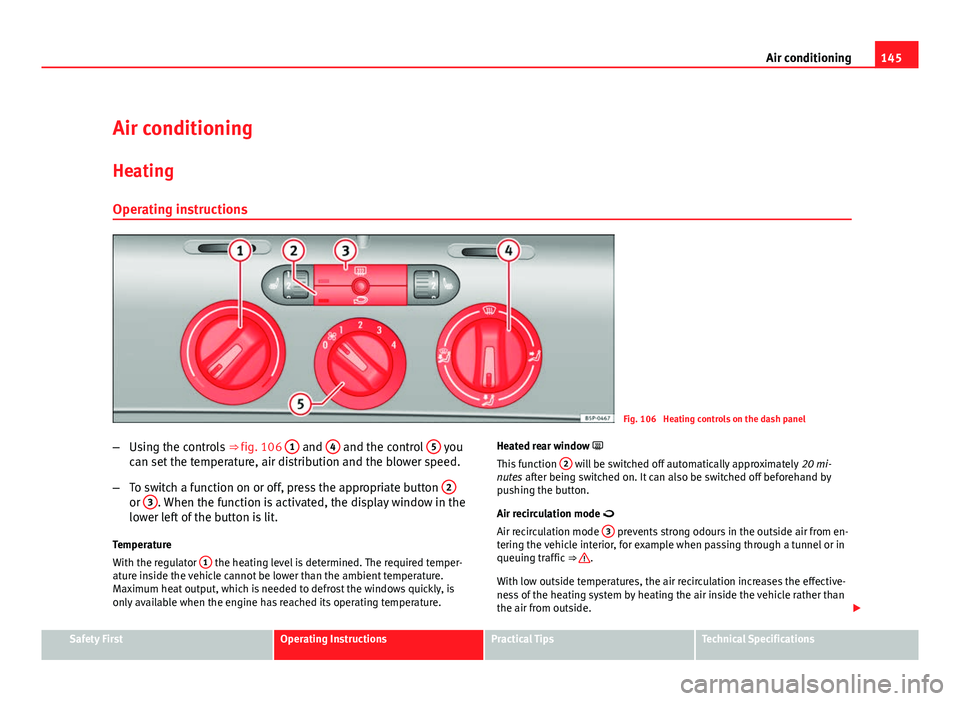
145
Air conditioning
Air conditioning Heating
Operating instructions
Fig. 106 Heating controls on the dash panel
– Using the controls ⇒ fig. 106 1
and 4 and the control 5 you
can set the temperature, air distribution and the blower speed.
– To switch a function on or off, press the appropriate button 2
or 3. When the function is activated, the display window in the
lower left of the button is lit.
Temperature
With the regulator 1
the heating level is determined. The required temper-
ature inside the vehicle cannot be lower than the ambient temperature.
Maximum heat output, which is needed to defrost the windows quickly, is
only available when the engine has reached its operating temperature. Heated rear window
This function
2
will be switched off automatically approximately
20 mi-
nutes after being switched on. It can also be switched off beforehand by
pushing the button.
Air recirculation mode
Air recirculation mode 3
prevents strong odours in the outside air from en-
tering the vehicle interior, for example when passing through a tunnel or in
queuing traffic ⇒
.
With low outside temperatures, the air recirculation increases the effective-
ness of the heating system by heating the air inside the vehicle rather than
the air from outside.
Safety FirstOperating InstructionsPractical TipsTechnical Specifications
Page 148 of 302
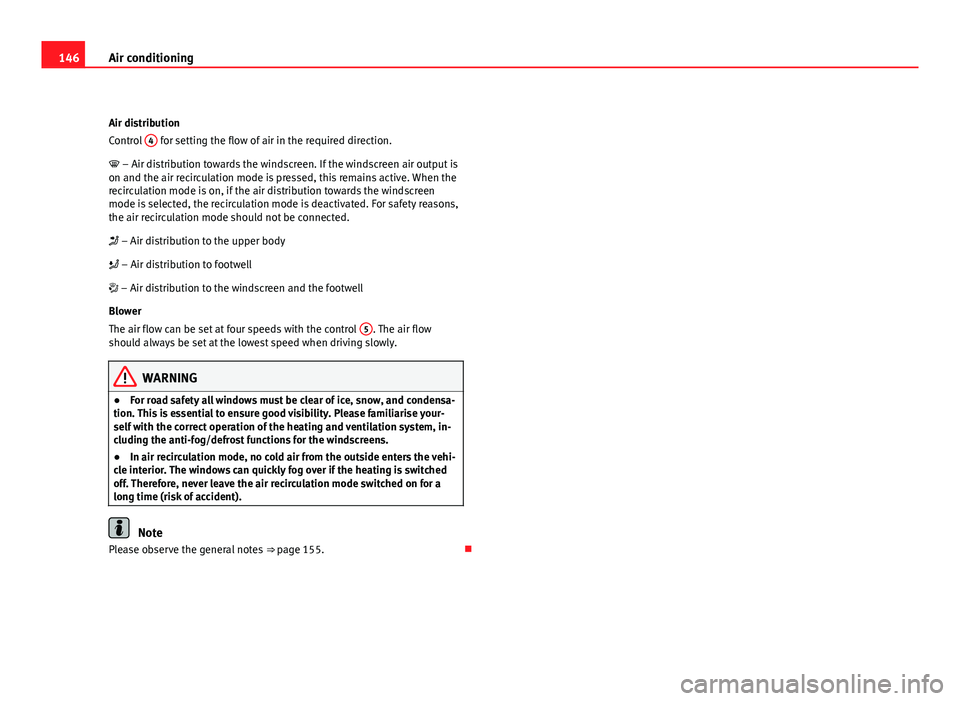
146Air conditioning
Air distribution
Control 4
for setting the flow of air in the required direction.
– Air distribution towards the windscreen. If the windscreen air output is
on and the air recirculation mode is pressed, this remains active. When the
recirculation mode is on, if the air distribution towards the windscreen
mode is selected, the recirculation mode is deactivated. For safety reasons,
the air recirculation mode should not be connected.
– Air distribution to the upper body
– Air distribution to footwell
– Air distribution to the windscreen and the footwell
Blower
The air flow can be set at four speeds with the control 5
. The air flow
should always be set at the lowest speed when driving slowly.
WARNING
● For road safety all windows must be clear of ice, snow, and condensa-
tion. This is essential to ensure good visibility. Please familiarise your-
self with the correct operation of the heating and ventilation system, in-
cluding the anti-fog/defrost functions for the windscreens.
● In air recirculation mode, no cold air from the outside enters the vehi-
cle interior. The windows can quickly fog over if the heating is switched
off. Therefore, never leave the air recirculation mode switched on for a
long time (risk of accident).
Note
Please observe the general notes ⇒ page 155.
Page 149 of 302
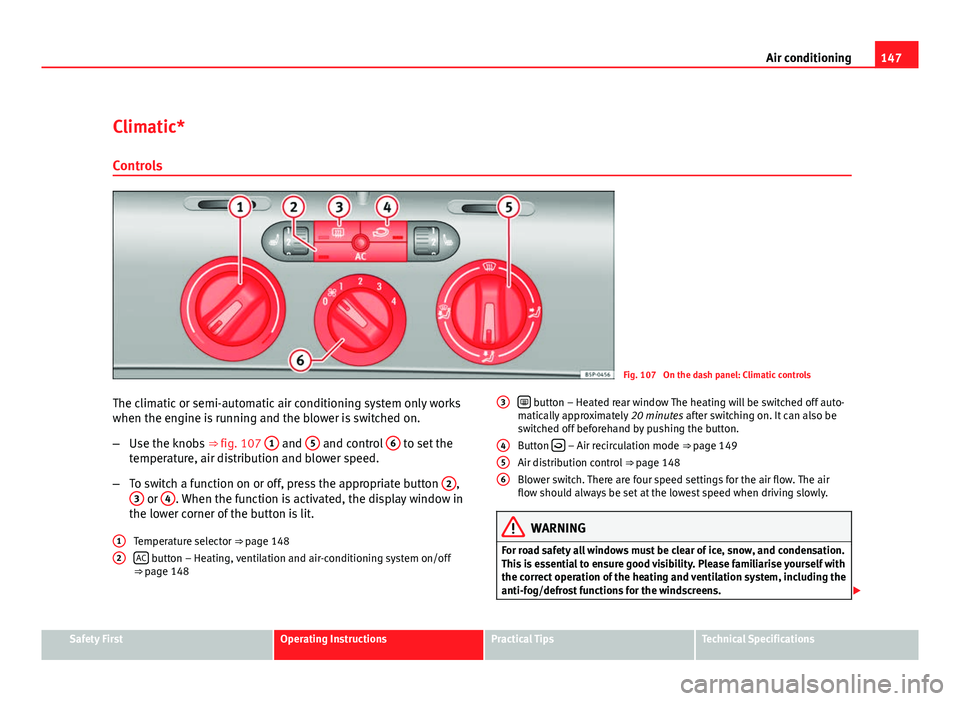
147
Air conditioning
Climatic* Controls
Fig. 107 On the dash panel: Climatic controls
The climatic or semi-automatic air conditioning system only works
when the engine is running and the blower is switched on.
– Use the knobs ⇒ fig. 107 1
and 5 and control 6 to set the
temperature, air distribution and blower speed.
– To switch a function on or off, press the appropriate button 2
,
3 or 4. When the function is activated, the display window in
the lower corner of the button is lit.
Temperature selector ⇒ page 148
AC
button – Heating, ventilation and air-conditioning system on/off
⇒ page 148
12
button – Heated rear window The heating will be switched off auto-
matically approximately 20 minutes after switching on. It can also be
switched off beforehand by pushing the button.
Button
– Air recirculation mode ⇒ page 149
Air distribution control ⇒ page 148
Blower switch. There are four speed settings for the air flow. The air
flow should always be set at the lowest speed when driving slowly.
WARNING
For road safety all windows must be clear of ice, snow, and condensation.
This is essential to ensure good visibility. Please familiarise yourself with
the correct operation of the heating and ventilation system, including the
anti-fog/defrost functions for the windscreens.
3
456
Safety FirstOperating InstructionsPractical TipsTechnical Specifications
Page 150 of 302

148Air conditioning
Note
Please observe the general notes ⇒ page 155.
Heating and cooling the interior
Fig. 108 On the dash panel: Climatic controls
Interior heating
– Turn the temperature selector ⇒ fig. 108 1
clockwise to select
the required temperature.
– Turn the blower switch to one of the settings 1-4.
– Set the air distribution control to the air flow configuration de-
sired:
(towards the windscreen), (towards the chest), (towards the footwell) and (towards the windscreen and
footwell areas). Interior cooling
–
Switch on the air conditioner using the button ⇒ fig. 107 AC
.
– Turn the temperature selector anti-clockwise until the desired
cooling output is reached.
– Turn the blower switch to one of the settings 1-4.
– Use the air distribution control to guide the flow of air in the re-
quired direction:
(to the windscreen), (to the upper
body), (to the footwell) and (to the windscreen and to the
footwell).